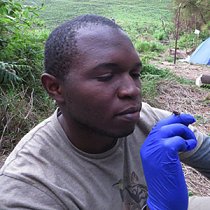
Geraud Tasse
Mapping frog population structure around Mount Koupe and Manengouba area with relevance to human population livelihood
Frogs are declining globally and anthropogenic disturbances advocate to be a major factor in local and global amphibian declines. Around Mount Manengouba-Cameroon, people collect adult frogs and even tadpoles due to their delicious taste, cultural purposes and presumed health benefits. Frogs are an important source of livelihood and remain an integral part of local medicinal heritage. Some species are seen as attractive characters in commercial advertising and others are collected or bred for the international pet trade. Despite the genuineness of these activities, very little is known on the rate frogs are collected from the field. A heavy exploitation may lead to local or global declines and potential extinctions through unsustainable collection. Using a multidisciplinary approach, I propose to study frog population structure in this area and their relevance to human livelihood. I aim at producing baseline data for a spatial map of frog population structure associating anthropogenic activities in the area. This research is essential for laying basis for monitoring and prioritizing efforts in the area. This will provide information on frog local communities and associations among some species around Mount Manengouba.